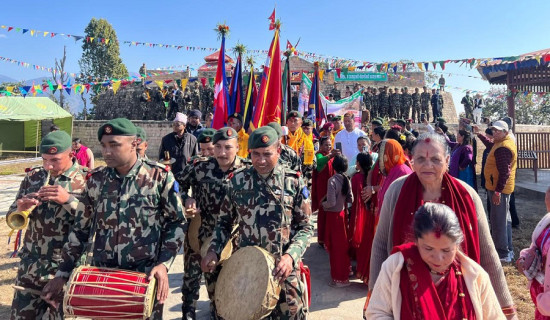- Friday, 9 January 2026
Accord Priority To Climate Diplomacy
Last week The Guardian published a climate survey report making an alarming revelation that the global heating is going to ‘blast past 1.5c target’ set by Paris Agreement in 2015. The report is based on the opinion of 400 climate experts from different parts of the world. Around 80 per cent of them predicted a 2.5c rise in the global temperature. Reacting to the survey report, the United Nations has warned that we are on the brink of ‘climate abyss’. This shows that the earth’s climate, fueled mostly by human activities, is undergoing a rapid change giving rise to a cascade of social, economic and environmental consequences and the global response to reverse the process of climate change are grossly inadequate.
Last month, a massive flash flood rattled the life in the United Arab Emirates causing huge devastation and death. Similar flood incidents were witnessed in Iran, Oman and Pakistan in the recent months. A flash flood triggered by a heavy rain after a prolonged drought wiped out several villages in Baghlan province in Afghanistan only a few weeks back, killing more than three hundred people. All these extreme weather events show that we are already in the midst of climate emergency. The climate change is a global crisis marked by a series of interconnected phenomena including rise in global temperature, melting of ice in polar regions and high mountains, deterioration in ecosystem and shifts in biodiversity. This process is primarily driven by the burning of fossil fuel and the emission of green house gases in the process of industrial and agricultural activities.
Extreme weather events
The earth’s average temperature is said to have increased by 1.2c since pre industrial era. Different parts of the world are already experiencing change in precipitation, extreme weather events, disruption in ecosystem and biodiversity. The more frequent and more devastating tornadoes in north America, prolonged drought and flashfloods in West Asia and Africa, hurricanes and volcanoes in East Asia and Pacific region and extreme monsoon pattern in South Asia are putting communities at risk of displacement, hunger and public health emergencies because of disruption in supply chain, energy supply and transport infrastructures.
The South Asian sub-continent where 25.2 per cent of global population lives is particularly vulnerable to cataclysmic consequences of climate change. This is the part of the world where Himalayan mountains and Indian Ocean form a symbiotic interconnection. The interaction of the Himalayas and the Indian Ocean forms a huge ecosystem which is maintained and regulated by monsoon rains irrigating crops and vegetation, replenishing underground water tables, maintaining flow in rivers, regulating temperature in the Indian Ocean, and saving the littoral regions of South Asia and the coast lines of Arabian Sea region from extreme climate events.
The beautiful and majestic snow crown of the Himalayan mountains is under sever strain of climate change. As temperature rises, the snow cap of the Himalayas is melting, resulting in glacial outburst, frequent avalanches and drying up of snow-fed rivers leaving the down stream human settlements, devoid of drinking and irrigation water. The ecological crisis in the Himalayas goes beyond the countries in its vicinity to affect life on the coast of Indian Ocean and the Arabian Sea. In recent years the events of debris flow emanating from the melting of permafrost and glacial lake outburst are wreaking havoc in the entire Himalayas and Hindu Kush regions.
The devastation that Melamchi Bazaar in Sindhupalchok district of Nepal witnessed in June 2021 was a grim reminder of the fragility of the mountain ecology and the vulnerability to human settlement along the river basins. The escalating cycles of extreme weather events around the world shows that the climate change mitigation measures are being fast overtaken in scale and pace by global warming. The stability of Himalayan ecosystem assumes paramount importance due to the fact that Himalayan snow is the source of three major river systems of South Asia. The Ganges, the Brahmaputra and the Indus River originate from the Himalayas and empty a huge volume of water in the Bay of Bengal and Arabian Sea.
The melting of the Himalayan snow will put the coastal communities of South Asia and the Gulf region at risk of submersion, subsidence and heat wave. The Guardian survey report indicates that climate change is no longer a distant distress call, it is already knocking our doors. The projection of dangerous escalation in global warming has drawn the world’s attention to the need of adopting stricter measures towards climate change mitigation, adaptation to climate-induced disasters and building resilience. In view of the severity of the challenges, it is imperative for all the countries to incorporate climate change mitigation and response as major component of international diplomacy.
Partnership
There is broad spectrum of possibilities for developing partnership in combating climate change impacts from diplomatic level. The Paris Agreement of 2015 is the first major milestone in the humanity’s effort to consciously combat climate-induced humanitarian crisis. On the basis of Paris Agreement, Nepal has been working with multilateral organisations in the field of climate change impact mitigation. The United Nations Framework Convention for Climate Change (UNFCCC) is one of them. It is drawing international attention to the worsening Himalayan ecology and what it means for the region around it. Green Climate Fund (GCF) and Indian Ocean Rim Association (IORA) are also working in the field of climate action facilitating inter regional dialogue to forge collaboration in dealing with climate change emergencies.
In conclusion, the world is facing a looming climate crisis as never before. The urgency and the enormity of the challenge demand a global response prioritising climate action in diplomatic agenda of all the countries. To cope with this crisis, the entire physical, financial, diplomatic and other institutional resources need to be mobilised aligning their efforts with the goal set by the Paris Agreement of 2015. This is the only option available for us today to forge a path to sustainable future for the humanity.
(Dr. Bharadwaj is former ambassador and former Chairperson of Gorkhapatra Corporation.)
















